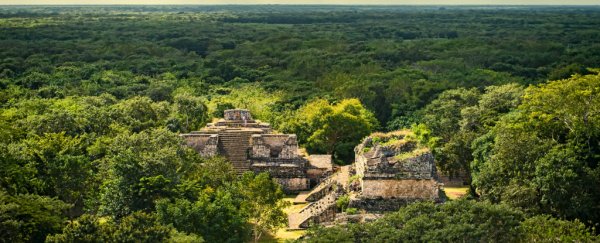Before its mysterious collapse more than 1,000 years ago, the Maya civilisation in Mesoamerica was home to one of the densest populations in human history.
But as the ancient and burgeoning civilisation spread across the Yucatan peninsula, it left a pernicious mark on the environment that can still be observed today.
A new study shows that centuries of deforestation by the Maya people have drastically changed the ability of local rainforests to store carbon in the ground. And even now - long after the Maya cities were mysteriously abandoned and the forests grew back - the region's carbon reserves have not yet fully recovered.
In many ways, the research is a warning against modern clear-cutting in the tropics, which is currently on a scale that would baffle even the ancient Maya. The study suggests this sort of behaviour could have serious repercussions for future greenhouse gas levels.
"When you go to [the Yucatan region] today, much of it looks like dense, old-growth rainforest," says lead author and geochemist Peter Douglas.
"But when you look at soil carbon storage, it seems the ecosystem was fundamentally changed and never returned to its original state".
Soil is a key ingredient in climate research because it is able to store an astounding amount of carbon - more than double the amount of Earth's atmosphere.
When plants die, the carbon they have removed from the atmosphere is transferred into the ground. And if the plant carbon attaches to a mineral, it can stick around in the soil for thousands of years.
This is the sort of carbon Douglas and his team set out to investigate. Because while the carbon reserves in soil have been studied across decades, scientists are still not sure what happens to them on timescales spanning centuries or even millennia.
Using sediment cores from the bottom of three lakes in the Maya Lowlands, Douglas and his team identified specific molecules in the samples, called plant waxes, which attach to minerals and are stored in the soil for a long time. The age of these molecules and surrounding plant fossils was then determined through radiocarbon dating.
The findings suggest a 70 to 90 percent decrease in the age of plant waxes, and these changes matched the land-use patterns of the ancient Maya. The results imply that after Maya deforestation, carbon was being stored in soils for much shorter periods of time.
"Putting these things together, we realised there was an important data-set here relating ancient deforestation to changes in soil carbon reservoirs," Douglas explains.
Not only do the findings offer a glimpse into the past, they also provide guidance for the future.
Atmospheric scientists agree that about 12 percent of all human-made climate emissions now come from deforestation, mostly in tropical areas. The new research suggests that if deforestation continues at the current rate, it could jeopardise one of the largest carbon sinks in the world, potentially speeding up the rapid warming of our planet.
"This offers another reason - adding to a long list - to protect the remaining areas of old-growth tropical forests in the world," Douglas says.
"It could also have implications for how we design things like carbon offsets, which often involve reforestation but don't fully account for the long-term storage of carbon."
In other words, planting trees is great, but if deforestation causes long-lasting harm to the soil's carbon reserves, it could all be for naught.
Now, Douglas hopes to take his research global.
"It would be great to analyse tropical forests in other regions of the world to see if the same patterns emerge - and to see if past human deforestation and agriculture had an impact on soil carbon reservoirs globally," Douglas says.
"I'm also very interested in applying this technique to permafrost regions in Canada to see what happened to carbon stored in permafrost during previous periods of climate change."
The study has been published in Nature Geoscience.
